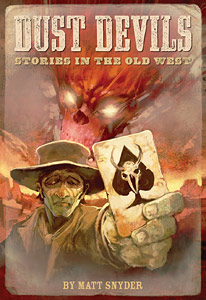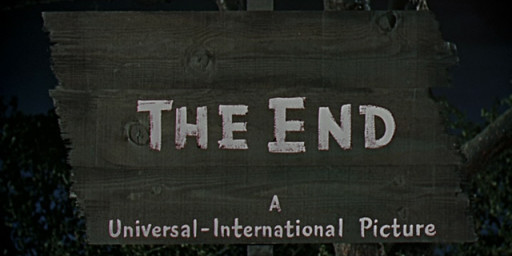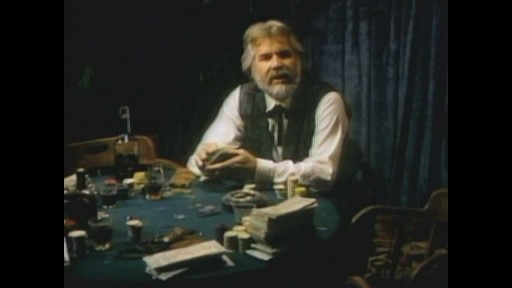You Should Be Playing…
Dust Devils
Shooting Fitzsimmons was a stupid thing to do, but when a man gets his hands on a knife and decides to plant it in your gut, what else are you supposed to do? Even when you are Marshal, and the man is your prisoner, and your last job is getting him on the train to Yuma, your instincts from years of walking the wrong side of the law held only one response.
Outside, the posse who came for vengeance howls for guilty blood. Inside, the poor doctor from back east works to save a man destined for a noose in Texas. The only things standing between old Fitzy and the posse out for him are you, your badge, and your six-gun. The medicine the doctor gave you for the gut wound starts to work its magic, and you feel the pain ebb away. Counting your rounds, you have sixteen bullets to stop twelve men, and even at your best, that was a fight you wouldn’t bet on winning.
As far as dying goes, however, you beat the odds. It beats the noose you faced down five years back when you went straight. It beats dying an old man in your bed back at the ranch you bought one year back. And it sure as hell beats dying alone. You thumb the hammer back, take a breath, and step into the light, ready to make the afterlife a crowded place.
 Dust Devils is a roleplaying game of the Old West, written and designed by Matt Snyder. Released through his Stories You Play label, Dust Devils released in 2002 and won the Indie RPG Game of the Year award. A second edition was released in 2006, and it’s currently available for $10 through DriveThruRPG.
Dust Devils is a roleplaying game of the Old West, written and designed by Matt Snyder. Released through his Stories You Play label, Dust Devils released in 2002 and won the Indie RPG Game of the Year award. A second edition was released in 2006, and it’s currently available for $10 through DriveThruRPG.
In Dust Devils, players are tasked with telling a compelling story set in the Old West. It is important to note that Dust Devils, while about Westerns, is not set in the “Wild West” that many are used to thinking about. Inspired heavily by the storytelling in our modern Western, Dust Devils does not tell the story of inspiring, larger than life figures facing down impossible odds with their white hats glistening in the sun.
Indeed, the Old West of Dust Devils is not an untamed wilderness, filled with beasts, banditos, and Indians to threaten the noble hero. Even when it draws on source material from the cinema of the 1950’s and 60’s, Dust Devils sticks closer to the more realistic, morally ambiguous tales that have endured since their creation. At its core, Dust Devils is not about the escapist fantasy of being a cowboy fighting outlaws, but is instead about the gravitas and desperation of a person inhabiting the fringe of a society on the cusp of modernity.
Dust Devils taps into the tragic story central to the Western genre, standing alongside films like Shane, The Searchers, Unforgiven, and Tombstone. The main characters of Dust Devils are people torn between a difficult past and an uncertain future, driven by insatiable desires and subject to lofty ideals. Like the protagonists of a Western, these characters push long past what a sane and rational person would be willing to accept, continuing forward through hostile weather, insurmountable foes, and ever present setbacks.

Yes, I need these boots. They’re crucial to my character!
The protagonist of the Western is a figure drawn in strong lines, filled with a blend of realism and tropes that have made the character indelible in our imagination. While an active agent in their world, the Western protagonist is as much trapped by their circumstances as they are able to change them. The immediate world is under their control, and they can measure their worth by the sharpness of their eye and the speed of their hand.
Outside their immediate world, however, the larger world serves to grind them down into the dust that clings to their boots. Like the tragic heroes of Greek drama, the Western protagonist pushes forward on a course of their own creation, knowing full well that every step they take only gets them closer to that cold, dark spot on the top of Boot Hill. Dust Devils captures the difficult essence of this Western hero, and suffuses it throughout all aspects of their game.
Gameplay
When creating a character for Dust Devils, players should reach past the stereotypes of heroes and villains, and embrace a character who walks in between. Dust Devils gives players several tools to achieve this, making it easy to create these colorful characters. Player characters have a pool of points to spread between four Scores associated with a suit of cards, with each representing a different set of talents and abilities. Hand, for example, measures a character’s coordination, physical ability, and general speed and is tied to Spades.
 When being “dealt in” during a Challenge, a character receives a number of cards equal to the sum of their two most relevant Scores to construct their best hand of five cards out of. A character is then given a pair of Traits, usually in the form an evocative simile. Traits can be used to give a character an advantage in a Challenge in the form of an additional card draw, or can be acted against to earn a Chip.
When being “dealt in” during a Challenge, a character receives a number of cards equal to the sum of their two most relevant Scores to construct their best hand of five cards out of. A character is then given a pair of Traits, usually in the form an evocative simile. Traits can be used to give a character an advantage in a Challenge in the form of an additional card draw, or can be acted against to earn a Chip.
Once a player has determined their character’s Traits, they must decide their character’s Past and Present. Like any good Western character, the Past haunts a character and the Present offers a break from it. A dandy Gentleman from back east could have come to the West and become a Hired Gun, and a penniless Woman on the Run could settle down and become a successful Businesswoman. While not every Past and Present need to be drastically different, it allows more space for a character to come to life. Often, differences between the Past and the Present are what drives a character forward. The player divides a pool of points between their character’s Past and Present to represent how much of each they are skilled with. A character may tap their Past or Present to discard cards after the initial draw, drawing new cards from the deck to replace them.

Meet a Devil…
Finally, a player must design their character’s Devil. The Devil serves as the character’s worst nature, that one habit that they cannot kick, and that one bit of darkness they can never escape. The Devil should be detailed and thought out, tying into a character’s Present, Past, and Traits to bring the whole concept together.
Similar to their Traits, a character may act with or against their Devil in a Challenge. Acting with it will draw you more cards equal to your Devil’s rating, while acting against it will reduce the number of cards you draw. Acting against your Devil, however, awards you with a Chip. The Devil’s rating is a fluid thing, and is meant to change from situation to situation. As such, the player can set their character’s Devil to any rating between one and three at the start of a session.
All together, the process of character creation provides a brilliant framework to build a troubled person, struggling against their worst nature, to survive in a world that is far from friendly.
Dust Devils makes it easy to build iconic characters, but it is its gameplay system that makes those characters shine. Dust Devils is fast paced, cinematic, and incredibly thematic. When a character comes into conflict, either with each other or with the environment, a Challenge begins. The central mechanic of all action resolution boils down to being dealt a poker hand and playing it the best that you can. All players declare their character’s intention, and the Game Master serves as the Dealer. The Dealer declares the intentions of the opposing characters, and cards are dealt out to each participant. In the case of a static Challenge, like climbing a mountain or chasing down a wild horse, the Dealer deals out a stud hand to the middle of the table. Characters receive cards equal to the sum of the two most appropriate Scores, plus any applicable Traits or Devils. Cards are discarded through Pasts or Presents, new cards are drawn, and all hands are Called.
Once a hand is Called, the highest card becomes the Narrator for the scene, and players compare the best hand of five cards made from the cards dealt to them. Provided no one with a stronger hand opposed their action, the Narrator describes how each character succeeds at their task based on the strength of their hand. Direct opposition between characters leads to Harm being inflicted based on the difference between the winning hand and the losing hand, causing the Scores used in the Challenge to be lowered.
Chips can be earned and spent during a Challenge for various effects. Chips are earned by acting against ones Traits or Devil, or by staking them into a Challenge. Winning a Challenge with a Chip staked earns more Chips, while losing causes them to be discarded. Chips can be spent to draw or redraw an additional cards, or to fold. Folding causes your character to back out of the Challenge, failing at their intention but prevents them from receiving Harm. Finally, Chips may be used to heal Harm, increasing a damaged Score – so long as it has not reached 0. Once a Score reaches 0, it remains there until the End or it is Redeemed through another character’s End. Anytime a character participates in a Challenge with a Score at 0, they enter the End unless they spend Chips to delay the inevitable. The End serves as the pivotal moment for a character, providing one last moment of glory before their story ends.
When The End Comes
 Once the End happens, that player becomes the Narrator, using their Devil in place of any 0 Score, and their character gets one last shot to make a difference. The End is a powerful mechanic in Dust Devils, and it allows players as much control as possible over how their character exits the story. During the End, the player may spend Chips to directly inflict Harm on other characters or to Redeem any character in the story. Chips spent to Harm a character reduces their Score, and Chips spent to Redeem a character can heal any of their Scores, including scores at 0.
Once the End happens, that player becomes the Narrator, using their Devil in place of any 0 Score, and their character gets one last shot to make a difference. The End is a powerful mechanic in Dust Devils, and it allows players as much control as possible over how their character exits the story. During the End, the player may spend Chips to directly inflict Harm on other characters or to Redeem any character in the story. Chips spent to Harm a character reduces their Score, and Chips spent to Redeem a character can heal any of their Scores, including scores at 0.
The End is an intrinsic part of the system of Dust Devils, just as it is an inescapable part of the Western. Everyone in the Old West eventually has to face their own Devil. Yet how the End happens is under the control of the player. They can go out in a blaze of glory, guns blazing at high noon, or in a quiet moment of introspection, burying their sidearm at Boot Hill. Once the End is concluded, the character leaves the story and play continues.
In the most recent release of Dust Devils, Snyder added to his pitch perfect game with three variants. Deathwish provides a game of espionage and covert agents, Ronin channels the spirit of Kurosawa and the chushingura of the Sengoku period, and Concrete Angels offers a game of femme fatales and hard nosed gumshoes set against the backdrop of the soul-crushing city. By giving these additional templates, Snyder moves Dust Devils out of being simply a niche game of gunslingers and outlaws, and takes on the challenge of writing a game system about the tragedy at the heart of the heroic narrative. The characters in Dust Devils may not always be good people, but they tap into the heart of the heroic story that has always been part of our storytelling. Through its evocative character creation, immersive conflict resolution, and the inescapability of the End, Dust Devils challenges you to answer the question central to all heroes. Is it better to fight and die, or compromise and live?
And that is why you should be playing Dust Devils.
David Gordon is a regular contributor to the site. A storyteller by trade and avowed tabletop veteran, he is always on the lookout for creative tabletop games. He can be reached at dave@cardboardrepublic.com.
You can discuss this article and more on our social media!
Photo Credits: Dust Devils cover by Stories You Play; Cowboy Boots by Stockvault; Dust Devils Playing Cards by Redbox Editoria; Tasmanian Devil by Warner Bros.; Kenny Rogers as “The Gambler” by Ken Kragen Productions; Destry (1954) by Universal.

